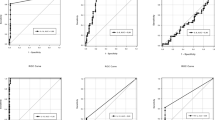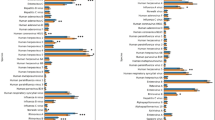Abstract
Background:
Although the human adenovirus-36 (Ad-36) has been associated with obesity and related lipid disorders in the United States, this association has yet to be identified in other countries. Therefore, we tried to determine whether Ad-36 is associated with obesity or lipid disorders in Korean schoolchildren.
Method:
A total of 318 Korean schoolchildren aged 6–15 years, who participated in the Ewha Womans University Obesity Research Study, were selected for a community-based cohort study. Non-obese and obese were defined as body mass index (BMI) <85th and ⩾95th percentiles of the Korean reference BMI-for-age curves, respectively, according to International Obesity Task Force definitions. The cutoff points for lipid disorders were modified from the age-modified standards of the National Cholesterol Education Program (NCEP)-Adult Treatment Panel (ATP) III metabolic syndrome criteria. The Ad-36 antibody was measured using a serum neutralization assay.
Results:
More obese participants than non-obese participants tested positive for the Ad-36 antibody (28.57 vs 13.56%, respectively; P=0.0174). Within the obese group, the participants who tested positive for the Ad-36 antibody had higher levels of triglycerides (TG) and total cholesterol than those who tested negative for the Ad-36 antibody (P<0.001). However, these associations were not present in the non-obese group. The unadjusted odds ratio (OR) for Ad-36 antibody positivity was greater in obese participants than non-obese participants (OR=2.550, 95% confidence interval (CI): 1.154–5.633). However, this OR seemed to be nonsignificant when age, sex and lipid variables were included in the analysis (OR=1.752, 95% CI: 0.763–4.020). The unadjusted OR for the elevated TG was significantly higher in participants who were Ad-36 antibody-positive than those who were Ad-36 antibody-negative (OR=2.511, 95% CI: 1.448–4.353). This trend remained constant even after adjustment for age, sex and obesity (OR=2.328, 95% CI: 1.296–4.181).
Conclusion:
Ad-36 seems to be strongly associated with lipid disorders in Korean schoolchildren regardless of obesity.
This is a preview of subscription content, access via your institution
Access options
Subscribe to this journal
Receive 12 print issues and online access
$259.00 per year
only $21.58 per issue
Buy this article
- Purchase on Springer Link
- Instant access to full article PDF
Prices may be subject to local taxes which are calculated during checkout
Similar content being viewed by others
References
Guilherme A, Virbasius JV, Puri V, Czech MP . Adipocyte dysfunctions linking obesity to insulin resistance and type 2 diabetes. Nat Rev Mol Cell Biol 2008; 9: 367–377.
Dhurandhar NV . Infectobesity: obesity of infectious origin. J Nutr 2001; 131: 2794S–2797S.
Atkinson RL . Viruses as an etiology of obesity. Mayo Clin Proc 2007; 82: 1192–1198.
Atkinson RL, Dhurandhar NV, Allison DB, Bowen RL, Israel BA, Albu JB et al. Human adenovirus-36 is associated with increased body weight and paradoxical reduction of serum lipids. Int J Obes 2005; 29: 281–286.
Dhurandhar NV, Whigham LD, Abbott DH, Schultz-Darken NJ, Israel BA, Bradley SM et al. Human adenovirus Ad-36 promotes weight gain in male rhesus and marmoset monkeys. J Nutr 2002; 132: 3155–3160.
Hong YM, Moon KR, Seo JW, Sim JG, Yoo KW, Jeong BJ et al. National wide study on body mass index, skinfold thickness, arm circumference in Korean children. Korean J Pediatr 1999; 42: 1186–1206.
Kim JA, Kim SM, Lee JS, Oh HJ, Han JH, Song Y et al. Dietary patterns and the metabolic syndrome in Korean adolescents: 2001 Korean National Health and Nutrition Survey. Diabetes Care 2007; 30: 1904–1905.
Friedewald WT, Levy RI, Fredrickson DS . Estimation of the concentration of low-density lipoprotein cholesterol inplasma, without use of the preparative ultracentrifuge. Clin Chem 1972; 18: 499–502.
Gil TY, Sung CY, Shim SS, Hong YM . Intima-media thickness and pulse wave velocity in hypertensive adolescents. J Korean Med Sci 2008; 23: 35–40.
Dhurandhar NV, Israel BA, Kolesar JM, Mayhew GF, Cook ME, Atkinson RL . Increased adiposity in animals due to a human virus. Int J Obes Relat Metab Disord 2000; 24: 989–996.
Pasarica M, Shin AC, Yu M, Ou Yang HM, Rathod M, Jen KL et al. Human adenovirus 36 induces adiposity, increases insulin sensitivity, and alters hypothalamic monoamines in rats. Obesity 2006; 14: 1905–1913.
Vangipuram SD, Yu M, Tian J, Stanhope KL, Pasarica M, Havel PJ et al. Adipogenic human adenovirus-36 reduces leptin expression and secretion and increases glucose uptake by fat cells. Int J Obes 2007; 31: 87–96.
Dhurandhar NV, Israel BA, Kolesar JM, Mayhew G, Cook ME, Atkinson RL . Transmissibility of adenovirus-induced adiposity in a chicken model. Int J Obes Relat Metab Disord 2001; 25: 990–996.
Anastos K, Lu D, Shi Q, Tien P, Kaplan R, Hessol N et al. Association of serum lipid levels with HIV serostatus, specific antiretroviral agents and treatment regimens. J AIDS 2007; 45: 34–42.
El-Sadr WM, Mullin CM, Carr A, Gibert C, Rappoport C, Visnegarwala F et al. Effects of HIV disease on lipid, glucose and insulin levels: results from a large antiretroviral-naive cohort. HIV Med 2005; 6: 114–121.
Acknowledgements
The research was supported by the Catholic University of Korea, Research Fund 2009, Korea Rural Development Administration, by grant from the GRRC of the Catholic University of Korea and was supported financially by MKE and KOTEF through the Human Resource Training Project for Strategic Technology. Ha-Na Na was supported by grant from the health fellowship foundation of the Yuhan Corporation.
Author information
Authors and Affiliations
Corresponding authors
Rights and permissions
About this article
Cite this article
Na, HN., Hong, YM., Kim, J. et al. Association between human adenovirus-36 and lipid disorders in Korean schoolchildren. Int J Obes 34, 89–93 (2010). https://doi.org/10.1038/ijo.2009.207
Received:
Revised:
Accepted:
Published:
Issue Date:
DOI: https://doi.org/10.1038/ijo.2009.207
Keywords
This article is cited by
-
Adenovirus 36 prevalence and association with human obesity: a systematic review
International Journal of Obesity (2021)
-
What we know and what we need to know about adenovirus 36-induced obesity
International Journal of Obesity (2020)
-
Adenovirus 36 seropositivity is related to obesity risk, glycemic control, and leptin levels in Chilean subjects
International Journal of Obesity (2020)
-
Ileal transcriptome analysis in obese rats induced by high-fat diets and an adenoviral infection
International Journal of Obesity (2019)
-
Is early life exposure to polyomaviruses and herpesviruses associated with obesity indices and metabolic traits in childhood?
International Journal of Obesity (2018)



